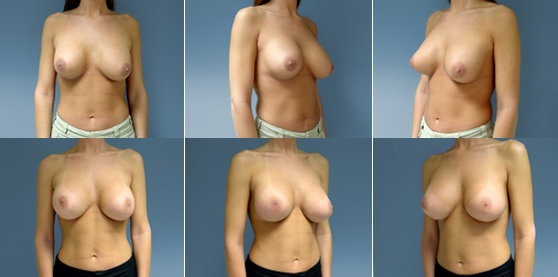Updated September 2018
When breast implants, or any other foreign object, are placed in the body, the body forms a lining around it. This lining, or capsule, is formed by your own living tissue. Many people refer to this lining as the "capsule", "tissue capsule", or "scar capsule", although it is not exactly the same thing as scar tissue. This is the body's natural response to a foreign object.
Signs of capsular contracture
Capsule contracture, the most common complication of breast augmentation surgery, can occur at any time. But capsular contracture seems to be more common in the first several months after surgery.
At the time of the initial surgery, a pocket is made for the implant. During the healing process, a capsule forms, which is comprised of fibrous tissue. The body is genetically programmed to shrink scar tissue somewhat. Under normal conditions, the pocket remains open, thus allowing the implant to look and feel natural. However, in some people, the capsule will tighten and squeeze the implant. This makes the breast implant feel hard, and distorts the appearance of the breast. In the later stages, the implant feels very firm and may take on a "ball-like" look.
It is important to remember that it is not the implant that has hardened; the shrinking of the capsule compresses the implant, causing it to feel firm/hard. However, once the implant is removed, it is just as soft as it was the day it was inserted.
Capsular contracture grades
: the Baker grading system - 4 grades of capsular contracture
- Baker Grade 1 - The breast is normally soft, and looks natural. (Basically, we all have this, since we all have a "capsule".) It is only when the capsule starts shrinking/contracting that capsule contracture occurs.
- Baker Grade II - The breast is a little firm, but appears natural.
- Baker Grade III - The breast is firm, and is beginning to appear distorted in shape.
- Baker Grade IV - The breast is hard, and has become quite distorted in shape. Pain/discomfort may be associated with this level of capsule contracture.
What causes capsular contracture?
Capsular contracture is an abnormal response to chronic inflammation, causing a buildup and tightening of collagen fibers in the scar capsule, as well as the formation of an abnormal cell called a myofibroblast, which can both produce collagen and contract like a muscle cell. This causes gradual deformation of the breast implant as it is constricted into a smaller space, with greater apparent firmness. This problem can be subtle, causing minimal changes to appearance and firmness; or severe, with significant implant deformation, migration, and hardness. It can be progressive over a period of months, stabilize, or even regress.
Historically, the cause of the chronic inflammation that, in turn, stimulates capsular contracture was free silicone oils from early model silicone gel implants. In those days, capsular contracture risk was all but certain, and usually severe.
Today, modern silicone gel implants have the same risk as saline implants, because the cause is now independent of the implant. The most common cause of capsular contracture is bacterial contamination of the implant, forming a ‘biofilm’ that cannot be removed from the implant. A secondary cause is excessive bleeding or bruising, or frank hematoma formation around the implant. However, some scientists believe this simply amplifies bacterial contamination, making the latter the most important cause.
For many surgeons, capsular contracture had become an accepted risk of doing the surgery. This had led to a feeling of acceptance by surgeons and a dogmatic belief that post-surgical implant massage will hopefully help. This attitude unfortunately has put the responsibility of a good surgical outcome on the patient, and that any sign of capsular contracture meant that her implant massage was somehow faulty. This is not the case, however, and we now know that at least to a certain extent, the surgeon has control of the outcome and reduction of risk.
About your risk for capsular contracture
The following are thought to put you at greater risk for developing capsule contracture:
- Transient germ contamination - Germ contamination and/or long-term bacterial contamination of the implant shell can cause an inflammatory reaction, thus leading to the shrinking of the capsule.
- Subglandular placement: Breast implants placed above the muscle tend to have higher capsular contracture rates, versus breast implants placed in behind the muscle, also known as submuscular placement.
- Infection: Capsular contracture seems to be more likely following an infection.
- Seroma: If you have had seroma, you may be at more risk for capsular contracture.
- Hematoma: Hematomas can cause an inflammatory reaction, which can lead to capsule contracture.
- Smoking: smoking decreases the oxygen levels in the blood, which could result in delayed healing, and possibly an inflammatory reaction.
That said, there are steps in the process of breast augmentation surgery that can be modified to limit your risk of developing capsular contracture.
Before and after photos: Capsular contracture
Photos provided by Dr. Revis
Reasons for Revision: Right breast capsular contracture; implant asymmetry
Corrective Procedures: Right breast capsulectomy; implant exchange
Pre-Op Implant: Saline smooth, round, moderate profile filled to 360cc
Post-Op Implant: Saline smooth, round, moderate profile filled to 625cc

------
Reasons for Revision: Capsular contracture; implant asymmetry
Corrective Procedures: Right breast capsulectomy; implant exchange
Pre-Op Implant: Saline smooth, round, moderate profile filled to 300cc
Post-Op Implant: Silicone smooth, round, moderate plus profile 400cc

Reviewed By



